Reading Time: 10 minutes
Walking routes can range from four-wheel drive roads to barely discernible animal pads or to no tracks at all! Some routes will be easy to follow and walk on, others may simply be off-track routes that are harder to locate and have obstacles to negotiate. Some of these challenging terrain conditions and useful techniques to overcome them, are described below.
Hard roads
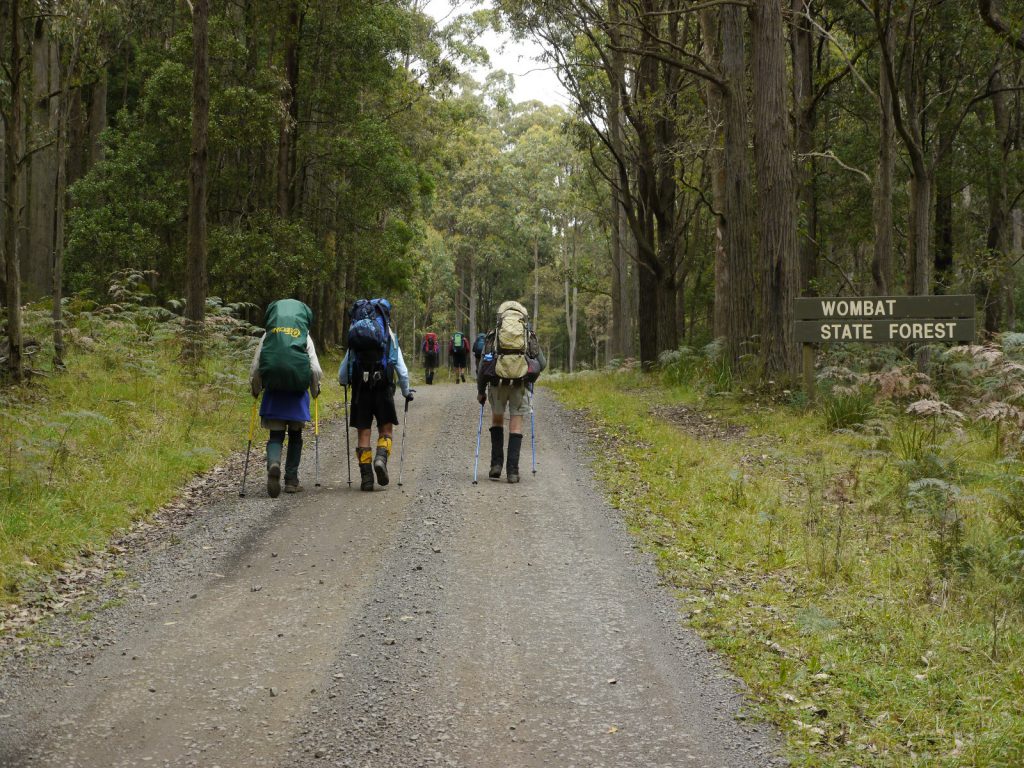
Walking on hard roads is most unpleasant, but sometimes unavoidable. More blisters are experienced when walking on hard roads than perhaps any other surface. Walking on the verge of the road where it is usually softer can reduce the impact. Wandering from side to side can make the walk longer, but if there is a camber on the road this may also make a difference. Changing from boots to more softly-padded sports shoes often helps, as does an extra pair of socks.
Duck boards

Many tracks today have duck boards or other forms of wooden ground protection. They don’t look or feel as good as a foot track on the ground, but they have been installed to minimise the damage done to the bush by so many feet. Duck boards are usually quick to travel on, so use them if provided, but be watchful of uneven spacing, damaged boards or raised chicken wire. They can be very slippery if covered by frost or smooth and wet, so take great care in these circumstances.
Walking on boards can be tedious over long distances as there are rarely any significant changes of direction to make the journey more interesting. There is a constant need to watch foot placement especially if the duckboards have small changes of direction. Care must be taken as steps can be difficult to distinguish and particularly on boardwalks that are significantly raised above the ground or swamp.
Sand

Travelling through soft sand is usually unpleasant and tiring. Walking on vegetated sand dunes is not recommended due to possible ecological damage. Alternative routes should be sought or planned.
Walking on dunes with no vegetation is generally tiring and slow, and should be kept to a minimum. It is often better to ascend dunes with a zigzag motion, and descend slowly and gently.
All walkers need to try to prevent sand getting into shoes or boots, as it rapidly causes blisters. For this reason, sand should be removed as soon as possible, and socks thoroughly shaken out. Gaiters can be very helpful to prevent sand getting in.
On the beach it is usually better to travel close to the water, where the sand is firmer. Walking at low tide and during the outgoing tide is usually preferable to trudging in soft sand at high tide. Unexpected big waves in the incoming tide can cause very wet feet or worse. If the walk schedule permits, it is often best to wait for the high tide to pass. Tide times are available from the Bureau of Meteorology, and are published by some fishing and motoring organisations. If a long walk on sand is unavoidable, consider changing or rotating footwear – boots, shoes/sandals, bare feet.
Mud

Good quality, solid boots and gaiters provide the best protection against mud.
Even though unpleasant, it is best to stay on the track, even when it is very muddy or wet. Going around a boggy part widens the wet section, creating visual scarring and environmental damage. Using a walking pole to test depth and check for obstacles can be useful.
After encountering mud, washing boots will help stop the movement of disease from one area to another. This is particularly important in areas affected by cinnamon fungus, a cause of die-back in eucalypt and other forest types. This is prevalent in many areas, including most of the karri forests of Western Australia and many of the forest areas in Victoria and Tasmania. In some areas there are ‘wash down’ or ‘scrub down’ stations set up for boot cleaning upon entering or leaving an area.
Steep ground
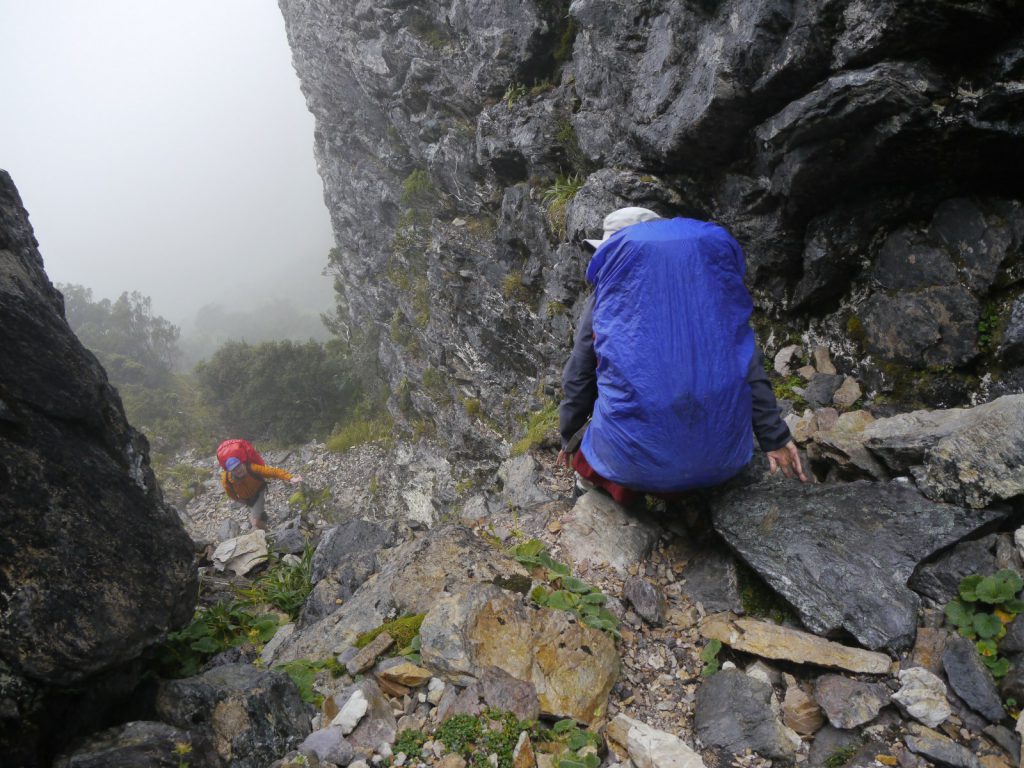
Only experienced groups should be undertaking trips in unfamiliar areas where steep terrain is likely to be encountered.
A review of the available maps, track notes and other information on the intended route will indicate if steep terrain is likely to be encountered. The trip leader must be confident that all group members are capable of safely negotiating such terrain. If there is any doubt, the leader should decline that person from participating on the trip, or revise the route.
When a section of steep ground is approached, leaders should be on the lookout for signs of nervousness among group members.
Group members should be reminded to:
- check footholds or handholds first before trusting weight onto them.
- stand vertically to let legs take body weight
- pause after each move to work out the best next move, however it is less tiring to use continuous motion as much as possible, within the bounds of safety.
- avoid leaning into the steep slope, as it not only tires arms, but feet are more likely to slip
- move only one hand or foot at a time, while retaining the other three on secure placements, thus always giving three points of contact, particularly if a move is tricky or there is any danger of falling
It is rare for bushwalking groups to carry a full-length climbing rope, but a short length of rope may be necessary or helpful for individuals or the whole group to haul or lower packs separately, in order to climb or descend a section unhindered. Removing packs can make a great deal of difference to some walkers’ confidence on steep ground. Before hauling or lowering packs, straps and pockets must be securely fastened to avoid catching or loss of contents. If in doubt, up-end the pack first and shake it. Wear gloves, if possible, to avoid rope burns if a slippage occurs. Lower packs gently to minimise damage, and make sure they cannot slip or roll away after the rope has been untied.
When a group is moving up or down steep slopes where there is no choice but to climb or descend directly above or below the next person, it is important that members are aware of the danger from falling rocks or other debris. Falling rocks can cause significant injury from an impact or may result in injury as someone tries to move out of the way. If it is impossible for group members not to be beneath one another, then it is far safer for each person to negotiate the obstacle separately.
If a rock or other object is dislodged and threatens others below, an immediate shout of ‘rock’ or ‘below’ is critical to give warning to those below.
On hearing the call of “rock”, each group member should know to look down and cover their head with their hands; making themselves as small a target as possible, and to never look up to see what is happening.
Scree slopes
Characteristics of steep, loose rocky ground (scree slopes) varies with some being quite stable and others having rock prone to sliding with each step. Care is required in either case to avoid injuries.
When a group is crossing a scree slope it is important that members are spaced across the slope and that no one is moving directly above anybody else, to avoid the danger from falling rocks. Falling rocks can cause injury from an impact, or as a result of someone moving out of the way and slipping or falling. If it is impossible for group members not to be beneath one another, then all should be as close together as possible. With large groups it may be necessary to move in smaller groups.
If a rock or other object is dislodged and threatens others below, an immediate shout of ‘rock’ or ‘below’ is essential to give warning.
Descending unstable scree slopes efficiently is usually done best through a controlled slide, a bit like skiing, rather than trying to completely control every step. This does however leave a ‘scar’ on the hillside.
Ascending unstable scree slopes is extremely tiring and best avoided. Seek an alternative route if at all possible.
Boulder hopping
Boulder hopping is not for everybody. It is usually preferable to avoid boulder hopping if an easier route is available.
Movement over large boulders involves similar issues to steep ground. The trip leader should watch for problems with the other group members and think about the extra time involved. Tightening straps on packs, including chest straps, can make movement and balance easier as long as it does not interfere with the movement of the lower torso and arms.
Carefully jump from one rock to another, making sure no one is in the way of the expected landing spot.
Ledges

Walking on ledges can be frightening for many people. Some known walking routes require a head for heights as they necessitate negotiating a complex route where there may also be a significant amount of exposure.
During the planning stage, having reviewed available track notes and other information on the intended route, leaders should ensure all group members are aware of known obstacles and must determine whether those wanting to participate have sufficient ability and experience to do so. It is better to find out then than being faced with having to solve the problem on the trip.
The usual advice for walking across ledges is to avoid looking down, but obviously that is not possible when it is necessary to see where feet are to be placed! Sometimes stopping, sitting and getting used to the sensation of being on a ledge can be helpful. Some people may like the security of having someone by their side, but on narrow ledges this is rarely possible or safe.
It can be helpful in building confidence for a very experienced group member to go first to show others that it is possible and the best and easiest way to do so.
Coastal walking/Coastal traverse
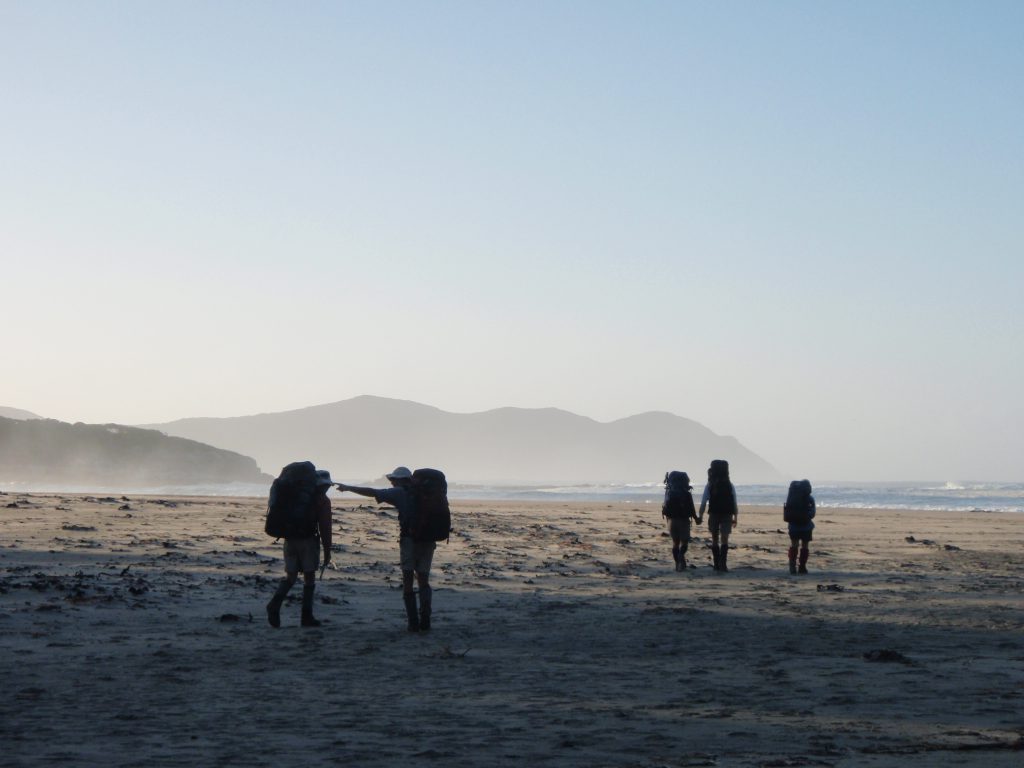
Some coastal traverses along the shoreline are recognised standard walks and well described by Parks Notes or Guidebooks. Such walks are safe in most weather and tide conditions, but it is crucial to know the state of tides and the weather forecast before setting out.
It is also important to keep an eye on the time while enjoying sandy beaches and exploring rock platforms and pools to ensure the group negotiates any obstacles, such as headlands, narrow sections of beach or rock platforms at low tide.
Cliff-backed shorelines
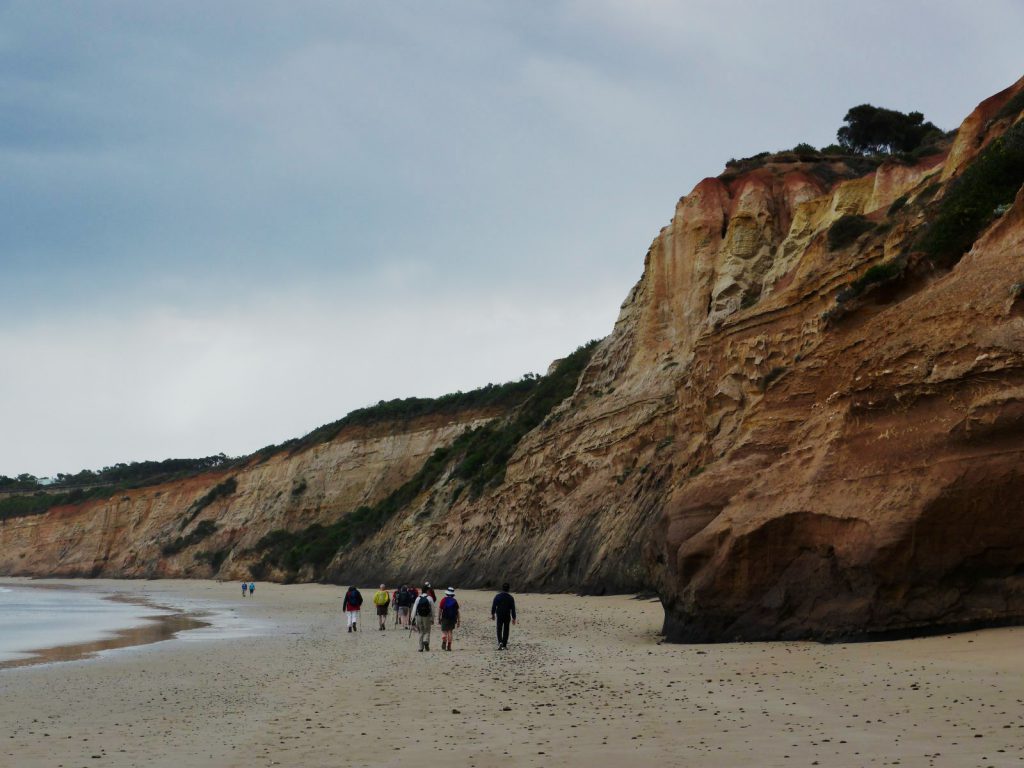
Traversing a narrow shoreline backed by unscalable cliffs can be highly dangerous and knowledge of escape routes off the coastline are essential. The consequences of entrapment are dire.
- Check maps and track notes to know at which points high seas or a rising tide will present problems.
- Never attempt to round a headland where the exit point is unknown and a rising tide or changing sea state might prevent backtracking.
- Never attempt a coastal traverse with a large group, or with beginners or children, without knowledge of multiple exit points.
- So called “rogue” or “freak” waves are actually regular occurrences and unusually large waves are a possibility on any coast at any time.
Creek and river outlets
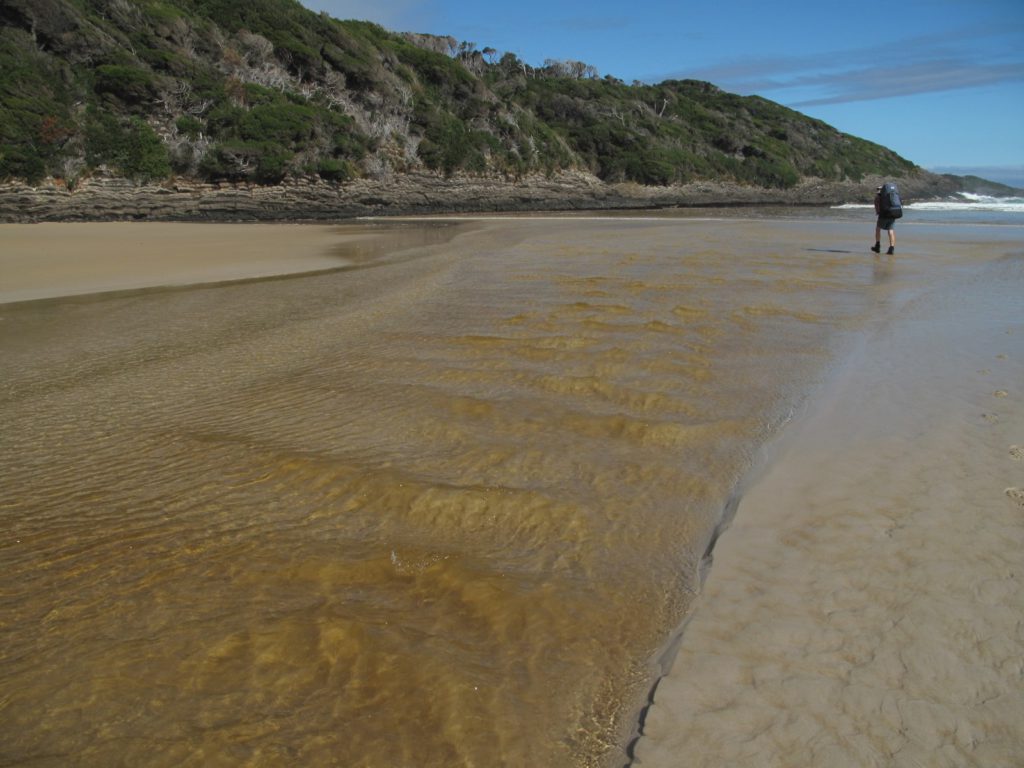
Storms and floods can alter a river’s outlet thereby making a crossing easier or more difficult than may have been expected.
Crossing flooded rivers on the coast is dangerous and should not be attempted. The possibility of a group member being washed out to sea is real. If a safe crossing point cannot be found inland, it is best to camp and wait for the water level to drop.
For detailed advice and techniques for crossing rivers safely see River crossings.
Walking along a dry river or creek bed
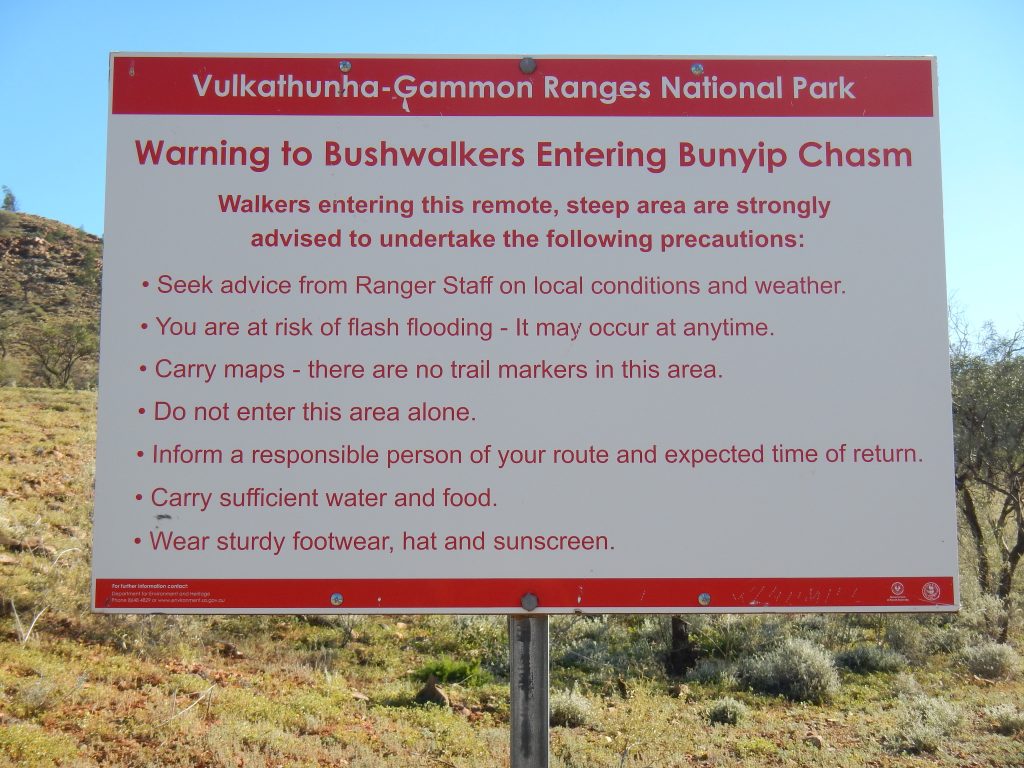
Carry a remote area emergency communication device.
In arid areas, for example the Flinders Ranges in South Australia, walking tracks or routes are often along dry creek or river beds. They often provide easier walking in otherwise very rough country. However there is the risk of a flash flood, which can arise from storm activity over the headwaters of a creek or river system some distance away. Eternal vigilance is required, especially when in gorge sections where there is the possibility of being trapped.
For this reason, never camp in the bed of a river or stream.
Snow and icy conditions
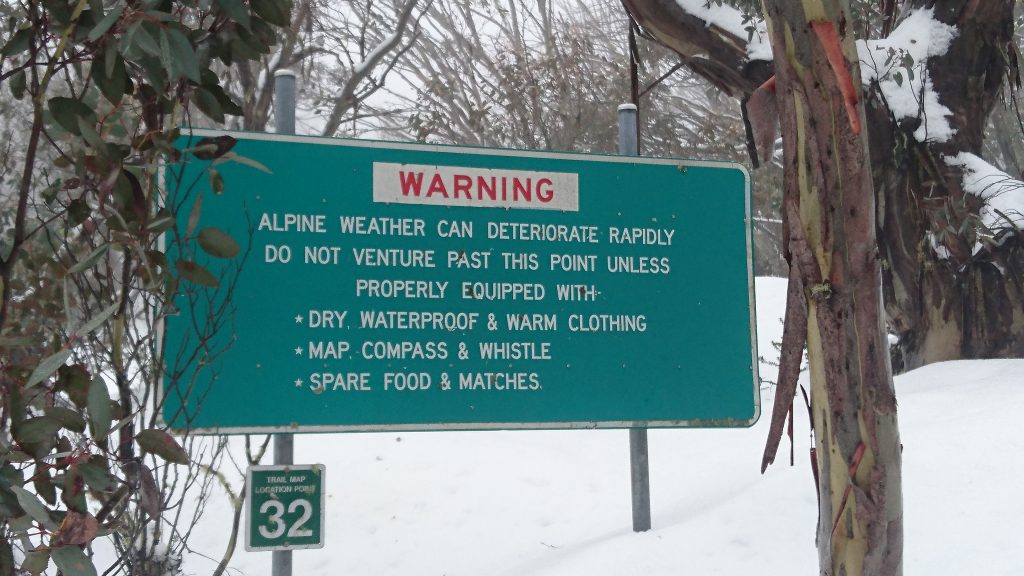
Check the weather forecast; carry a mobile phone.
Walking in conditions where snow and ice are a certainty requires sound knowledge, good fitness and sufficient experience as well as the right equipment. Good boots, gaiters and wet weather clothing are essential. Even on a day trip, a group should be equipped with an emergency shelter (e.g. Bothy), extra clothing and food.
Walking in snow is sometimes cold, sometimes hot, and always hard work.
- The group should walk in single file, everyone walking in the footprints of the person in front. Therefore, the person who is breaking the trail must be mindful of taking steps that are short enough for everyone to use. When steps are too long, it becomes tiring for shorter people and requires them to make new steps, which is even more tiring!
- The first person should only break trail for a short time (depending on fitness, ability and snow conditions) before stepping aside to allow the second person take over.
- The person who stepped aside waits for the whole group to pass and becomes the new whip.
- This should prevent tiring one person excessively by giving everybody a chance at breaking the trail.
- By the time the last person comes along, the trail should be well packed down. The last person should have a good trail and can use this time to catch their breath and energy before taking another turn at the front.
Using snowshoes is an advantage when snow is deep and soft. They provide more surface area to help support the weight of the person to stop them sinking in too deep. Snowshoes that are fixed at the heel are fine for flat terrain, but are unsuitable for steeper slopes. Those that are hinged work better on steeper terrain. Snowshoes are best used in conjunction with poles for added stability and balance.
In most parts of Australia, ice rarely covers a large area nor does it last very long, so avoiding it or waiting for it to soften are alternatives in most circumstances. If the ice is just a thin crust on the surface, then heavy stamping of the feet may break though and provide reasonably secure footing. This technique is not recommended for crossing wet boggy areas, and definitely not over lakes!
Steep snow and ice climbing, abseiling, rock climbing and canyoning
Bushwalking and ski touring can extend into related outdoor activities that involve very steep ground.
These activities require specialist skills, training, practice and equipment.
Any activity requiring a helmet, harness, ice axe, crampons or rope is outside the scope of this Bushwalking Manual.

